
"You are instructed to proceed with all speed to the island of Java
in the East Indies to accept the surrender of Japanese Imperial Forces
on that island, and to release Allied prisoners of war and civilian internees...
The main landing will be by the British Indian Army, 5th Division,
who have shown themselves to be most reliable since the Battle of El Alamein. Intelligence reports indicate that the landing should be at Surabaya, a location that affords a deep anchorage and repair facilities..."
A Letter from Mountbatten Vice Admiral Supreme Commander S.E. Asia
to G.O.C Imperial Forces
ON MISSION
On 17 August 1945 Indonesian independence was declared in Jakarta. However the Dutch were determined to re-establish colonial rule. Unable to send their own troops to the area, the Dutch requested British assistance. From here, the historical background will begin.
The Mountbatten’s letter to G.O.C. Imperial Forces above gave my imagination back to September 1945 (after the Japanese surrender). That was, The 5th, 23rd, 26th Indian Division and 5th British Parachute Brigade, and in the outer islands by 7th and 9th Australian Divisions have the task of recovering the many thousands of prisoners and internees in Indonesia and disarming and repatriating the large Japanese garrison was undertaken in Java and Sumatra.
Present day, a part of those fallen soldiers of British Indian Army were buried at Djakarta War Cemetery. Tuesday morning 24th of May 2011, I and Youfeta Devy explored this cemetery in Menteng Poelo. The location is adjacent to Ereveld Menteng Poelo. The cemetery is managed by Commonwealth War Graves Commission (CWGC), United Kingdom. This is my continuation journey about the war cemetery series in Indonesia. Previously, I have finished my journey to 7 Erevelden in Java (2006-2009) managed by Oorlogsgravenstichting (OGS), The Netherlands.
ACKNOWLEDGEMENT
I would express my gratitude to Mrs. Karen Loizou, CWGC Head Office – the Support Services for Outer Area, United Kingdom who gave the permission. Also Pak Setiadi Aripin, Manager of Jakarta War Cemetery who accompany and explain us about the history behind of this cemetery.
MAP MENTENG POELO AND ITS SURROUNDINGS
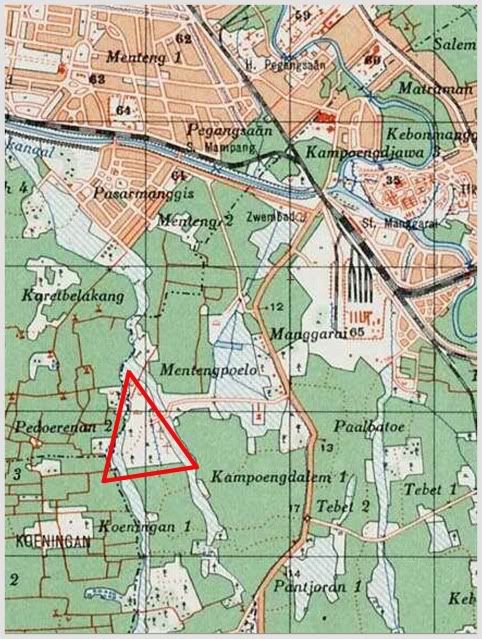
Note:
The red triangular is the area of the Menteng Poelo public cemetery
Garnizoenkaart "Batavia en Omstreken" (excerpt)
Survey date 1938
Published by batavia Topografische Dienst - 1940
Source: Koninklijk Instituut voor de Tropen - Nederlands
GROUND PLAN OF THE DJAKARTA WAR CEMETERY
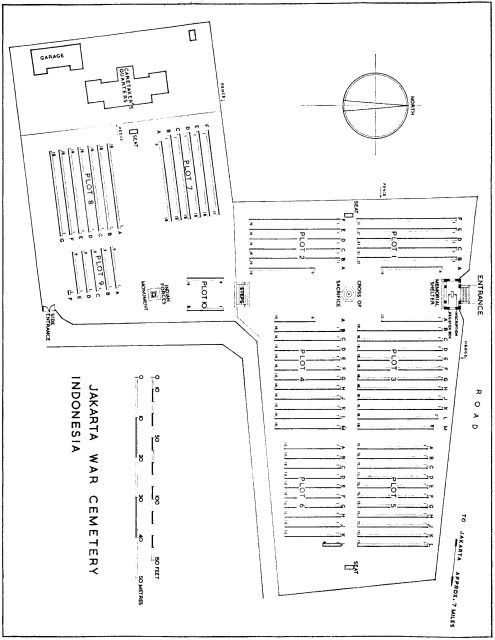
Source:
Commonwealth War Graves Comission - United Kingdom
__________________________________________
THE DJAKARTA WAR CEMETERY
The Cemetery which is open between the hours of 8.00 am and 5.00 pm. Monday to Friday. The Principal gate is on its northern side by a short flight of steps leading into a memorial building.
In 1961 at the request of the Indonesian Government, the Commonwealth dead from the Netherlands Field of Honour at Sourabaya, and from those at Palembang, Medan and Muntok in Sumatra, were brought into the cemetery, which already contained 474 Commonwealth war graves.
Jakarta War Cemetery therefore contains the graves of many who died in defense of Java and Sumatra during the swift Japanese advance in 1942 and many others who perished afterwards as prisoners of war.
Among the dead were sailors who fought in The Battle of Java Sea, and soldiers of "Blackforce" including a number of Australians whose graves lie together in plot 6, and airmen who died in flying battle and airfield defense.
The burials here number 1,181 (Navy 105, Army 783, Air Force 271, Merchant Navy 12, Malayan Police etc 10) of which 715 are British, 304 Indian, 96 Australian, 4 Canadian, 2 New Zealand, 1 South African, 1 Burmese, 22 Malayan, and 36 Allied and others.
THE DJAKARTA MEMORIAL
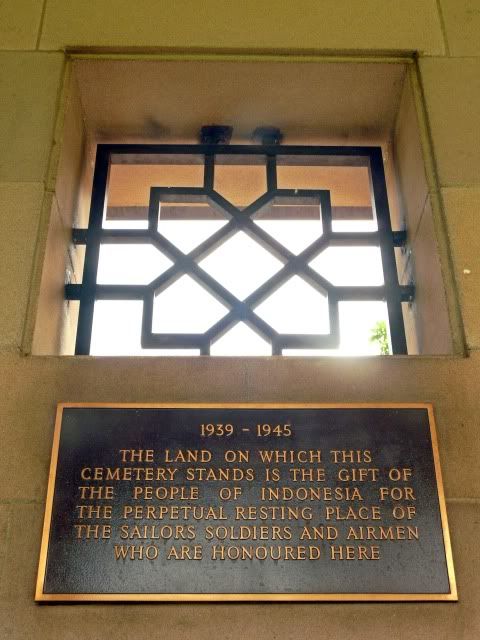
On the bronze panels at the entrance to the War Cemetery are commemorated by name 53 British and 5 Australian servicemen, and 72 of their comrades whose names are not known, who were executed at Soebang in 1942 and are buried at Antjol.
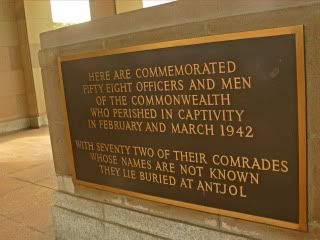
Land For the Perpetual Resting Place

Memorial Shelter
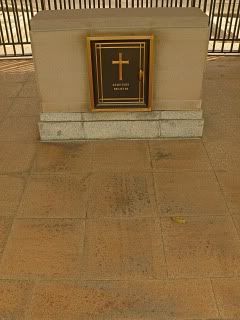
Cemetery Register
THE MONUMENTS
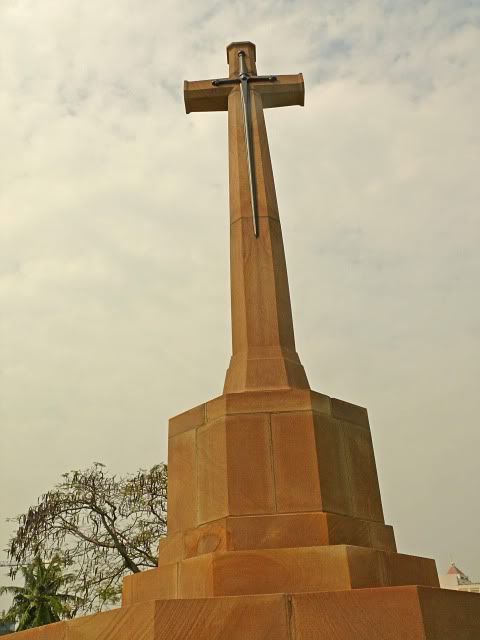
Cross of Sacrifice Monument
The Cross of Sacrifice was designed by Sir Reginald Blomfield for the Imperial War Graves Commission and is usually present in Commonwealth war cemeteries.
A freestanding four point limestone Latin cross. On the face of the cross is a bronze sword, blade down. It is usually mounted on an octagonal base. The Cross represents the faith of the majority of the dead and the sword represents the military character of the cemetery. The Cross of Sacrifice is frequently built into the boundary wall of cemeteries where subsidence is a liability
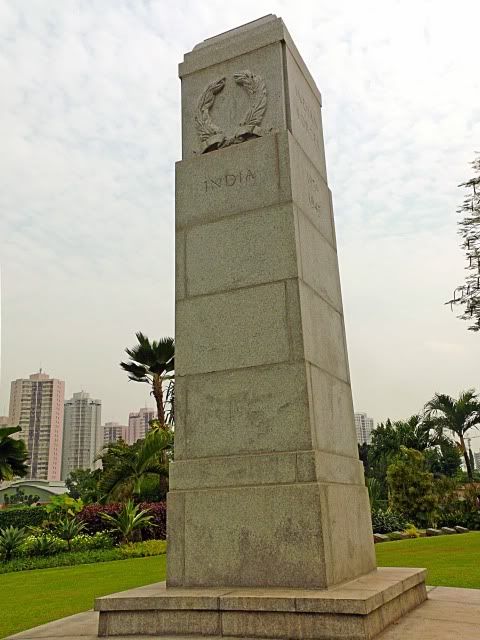
The Indian Forces monument
It is a stone pillar crowned by a sculptured wreath and bearing wreaths on two sides, with "INDIA" inscribed below one and "PAKISTAN" below the other. The cemetery of Indian Forces is covered with turf and planted with many colorful tropical trees and shrubs.
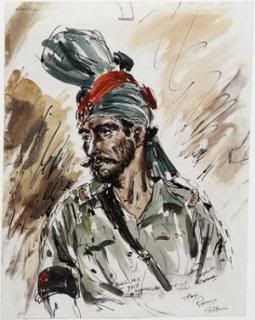
An Indian Military Policeman, Batavia
Tony Rafty - 1945
THE COMMONWEALTH WAR GRAVES COMMISSION
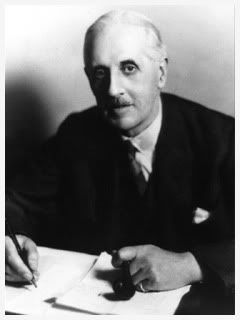
Major General Sir Fabian Arthur Goulstone Ware KCVO, KBE, CB, CMG
(17 June 1869 – 29 April 1949)
He was the founder of the Imperial War Graves Commission, now the Commonwealth War Graves Commission. Now, the president is Prince Edward, Duke of Kent.
The Commonwealth War Graves Commission (CWGC) was Established by Royal Charter in 1917. It is a non-profit-making organization.The CWGW pays tribute to 1.7 million Commonwealth servicemen and women who died during the WW1 and WW2, also maintain graves and memorials at some 23,000 locations in 150 countries.
They have a staff force of approximately 1,200 (majority stonemasons and gardeners) with an annual budget in the region of £40 million. This Commission operates through the continued financial support of the member states: United Kingdom, Canada, Australia, New Zealand, India and South Africa.
THE SYMBOL
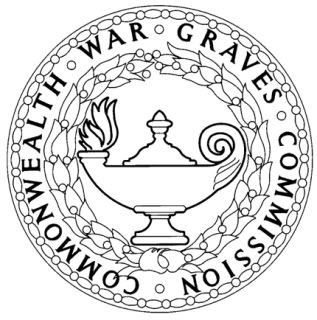
The lamp is symbolic of the immortality of the spirit, whereas the wreath of by leaves represents victory.
__________________________________________
THE 5TH DIVISION OF BRITISH INDIAN ARMY
THE LARGEST MOBILIZATION OF BRITISH MILITARY AFTER WW2
LANDED AT SOURABAJA 3rd NOVEMBER 1945
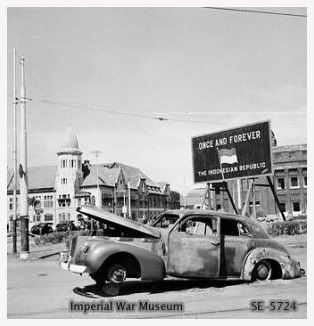
Army Film & Photographic Unit
Davis (Sergeant) and MacTavish (Sergeant)
19-22 November 1945
The burnt-out car of the late Brigadier Mallaby on the spot where he was murdered by Indonesian nationalists in Soerabaja on 30th October 1945.
The 5th Division have large number of 24,000 troops. This division is very famous because had participated in the battle at El Alamein,
where Marshal Rommel's troops (NAZI) defeated.
4th Indian Field Regiment.
5th Field Regiment.
24th Indian Mountain Regiment.
5th Mahratta (Anti-Tank Regiment/Artillery).
17th Dogra Machine-Gun Battalion.
1/3rd Madras Regiment (H.Q. Battalion).
3/9th Regiment (reconnaissance battalion)
9th Indian Infantry Brigade.
2nd West Yorkshire Regiment.
3/2nd Punjab Regiment.
1st Burma Regiment.
123rd Indian Infantry Brigade.
2/1st Punjab Regiment.
1/17th Dogra Regiment.
3/9th Gurkha Rifles.
161st Indian Infantry Brigade.
I/1st Punjab Regiment.
4/7th Rajput Regiment.
3/4th Gurkha Rifles.

____________________________________
THE PHOTOGRAPHS
BRITISH INDIAN ARMY ON ASSIGNMENT
These photographs below are owned by Imperial War Museum
London, United Kingdom.
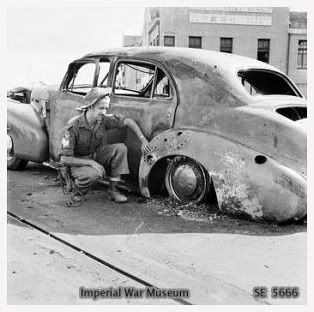
A British sergeant examines the burnt-out wreckage of Brigadier Mallaby's car on the spot where it was ambushed in Soerabaja.
The Brigadier murdered on 30th October 1945
in front of Internationale Crediet en Handelsvereeniging "Rotterdam" building.
Photo by Army Film & Photographic Unit - Hardy A (Company Sergeant Major).

Photo by Army Film & Photographic Unit - Davis (Sergeant)
30th November 1945
A poster put up by Indonesian nationalists in Soerabaja appealing to Indian troops not to fight against them.
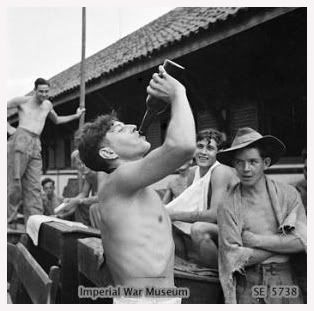
Photo by Army Film & Photographic Unit -
Davis (Sergeant) & MacTavish (Sergeant)
19-22 November 1945
During a lull in the fighting in Soerabaja an off-duty member of the 1st Battalion, The West Yorkshire Regiment gets time for a beer.
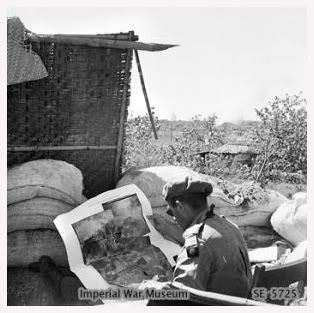
Photo by Army Film & Photographic Unit -
Davis (Sergeant) & MacTavish (Sergeant)
19-22 November 1945
Lieutenant Colonel A T Scott of the 9th Brigade, 5th Indian Division, studies an aerial photograph mosaic of Soerabaja during the British advance against Indonesian nationalists holding the town.
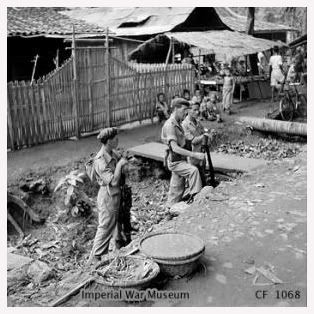
Photo by Woollacott (Sergeant) - Royal Air Force official photographer
Three members of a Royal Air Force Regiment patrol (from left to right: Leading Aircraftman C S Taylor, Leading Aircraftman M Smith, and Leading Aircraftman F H Whitehouse), armed with a Bren Gun and rifle grenades, act as cover during a systematic search of a kampong (village) in Java for weapons and ammunition held by Indonesian nationalists.
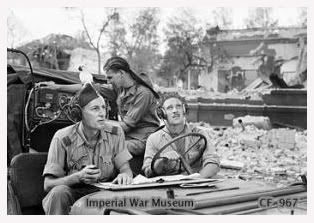
Photo by Royal Air Force official photographer
November 1945
Flight Lieutenant H McDonald DFC (left), Corporal D Mountford (wearing headphones) and Aircraftman D Jull manning a Royal Air Force Visual Control Post in conjunction with 123rd Brigade of the 5th Indian Division operating in Soerabaja.
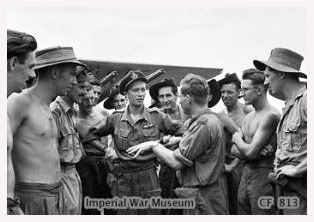
Photo by Lea (Sergeant)-Royal Air Force official photographer
November 1945
At Kemajoran airfield, Batavia, Warrant Officer James Gibson and Flight Lieutenant A Jacomb-Hood DFC of 47 Squadron, discuss their attacks on the radio stations at Soerakarta in Java that were held by Indonesian nationalist forces.
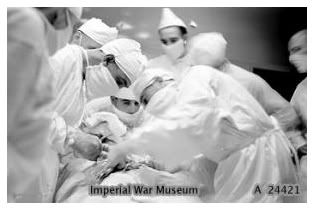
Photo by Rolfe, W E (Lt)-Royal Navy official photographer
May 1944
Medicine at Sea:
May 1944 on board HMS RENOWN during the lead up to the 17 May raid on Soerabaja, by a mixed British and American Naval fleet and Air Force. Marine Thomas Quinn, of Glasgow being operated on successfully for an appendicitis.

Photo by Woollacott (Sergeant)-RAF official photografer
December 1945
A Gurkha, wounded in fighting against Indonesian nationalists, is assisted from a Dakota transport aircraft at Batavia in Java.

Photo by Army Film & Photographic Unit - Heren (Captain)
14th March 1946
Captain Daniel, a company commander in one of the Frontier Force regiments of the 36th Indian Brigade, prepares to move off in the lead vehicle from Buitenzorg at the start of an operation to clear the northern road between Batavia and Bandoeng.
This operation was undertaken following the ambush of a convoy on the southern routes between Batavia and Bandoeng. It was decided that the northern road had to be cleared and then picquetted in North-West Frontier style to keep it open.
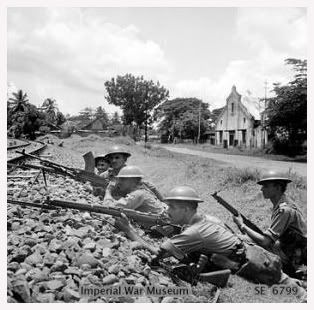
Photo by Army Film & Photographic Unit - Wright W B (Sergeant)
19th February 1946
Men of the 4/7th Rajputs in position alongside the railway line at Bekassi during a reconnaissance in force to locate positions held by Indonesian nationalists. The force moved off at dawn on 19 February 1946 towards Bekassi, 14 miles east of Batavia and the scene of a massacre of Indian soldiers and Royal Air Force personnel from a crash-landed Dakota aircraft.

Photo by Army Film & Photographic Unit - A. Lemon
31st December 1945
Lieutenant Colonel K T Darling of the 5th Parachute Brigade listens whilst a Dutch intelligence officer questions an Indonesian suspect during the operation to take control of all civil administration buildings in Batavia.
In December 1945 men of the 23rd Indian Division and 5th Parachute Brigade successfully occupied civil administration buildings in Batavia, including all police stations. Many members of the police force were suspected of collaboration with the nationalist.
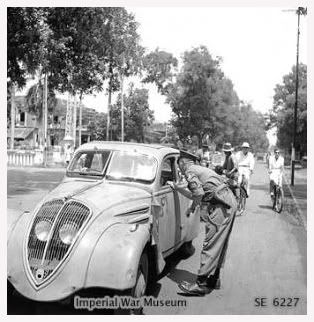
Photo by Army Film & Photographic Unit
28th December 1945
Corporal J Rothwell of the Corps of Military Police checks the occupants of a car at a roadblock on the outskirts on Batavia. In order to secure the safety of the population of Batavia a military cordon was thrown around the city to stop the inflow of bandits.
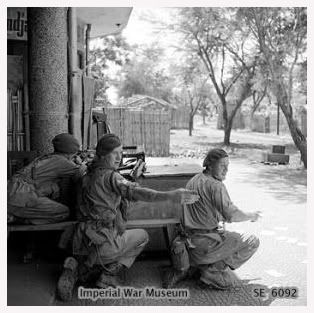
Photo by Army Film & Photographic Unit-Lemon A (Sergeant)
December 1945
Men of the 7th Battalion, The Parachute Regiment take cover after hearing shots from Indonesian nationalist snipers in the Kramat quarter of Batavia.
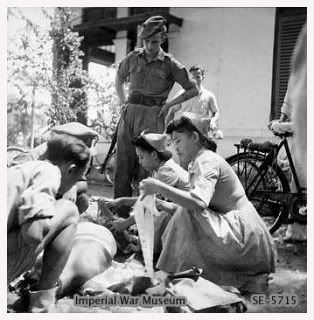
Photo by Army Film & Photographic Unit - Lemon A (Sergeant) and Stewart (Sergeant)
21st November 1945
A soldier of the 1st Battalion, The Seaforth Highlanders looks on as Red Cross nurses dress the wounds of an Indonesian civilian shot by Dutch Ambonese troops in Batavia. The man later died of his wounds.

Photo by Woollacott (Sergeant)-RAF
7th December 1945
Indian Mahratta troops load their equipment aboard a Dakota of 31 Squadron at Batavia in Java ready for a flight to Bandoeng.
In eight hours a squadron of Dakotas flew in 800 Indian troops to Bandoeng and the reloaded with Dutch internees and flew them to Batavia. Some crews undertook four flights into Bandoeng during this operation.
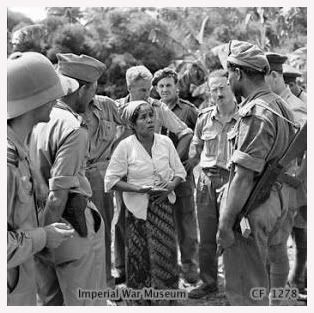
Photo by Royal Air Force official photographer
December 1946
An Indonesian woman is questioned during an operation to capture nationalist fighters who killed 20 Indian infantrymen and 5 Royal Air Force aircrew after the crash landing of a Dakota transport aircraft near the village of Bekassi, 15 miles from Batavia.
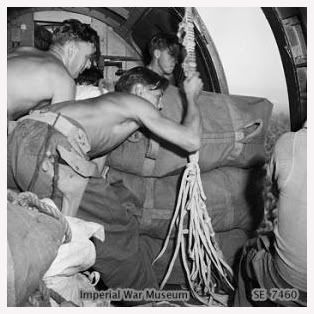
Photo by Army Film & Photographic Unit - Modd L. (Sergeant)
26th May 1946
Men of 70 Air Dispatch Unit push supplies out of a Dakota aircraft of 31 Squadron, Royal Air Force, during the daily air drop over Tjianjoer near the city of Bandoeng. Due to ambushes and sabotage by Indonesian nationalists on the roads between Batavia and Bandoeng.
Bandoeng is separated from Batavia by 130 miles of narrow road, which cuts through paddy fields and twisting mountain passes. Attacks on all but the most heavily armed convoys led to the adoption of an air supply service run by the Royal Air Force.
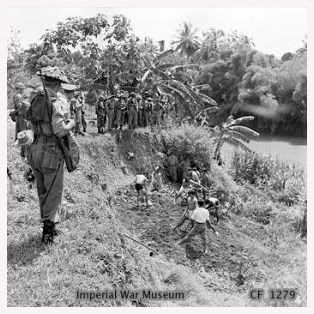
Photo by Royal Air Force official photographer
December 1946
British and Indian troops look on as villagers from Bekassi, 15 miles from Batavia in Java, dig to uncover the bodies of 20 Indian infantrymen and 5 Royal Air Force personnel killed by nationalist fighters after the crash landing of a Dakota transport aircraf.
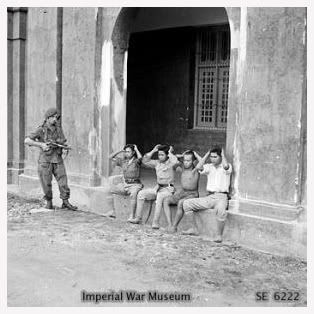
Photo by Army Film & Photographic Unit-Lemon A (Sergeant)
29th December 1945
Private W. Upton of the 5th Airborne Brigade stands guard over four recently disarmed Indonesian policemen in Batavia. On taking over civil administration buildings in the city it was found that many of the local police were armed with Japanese weapons.
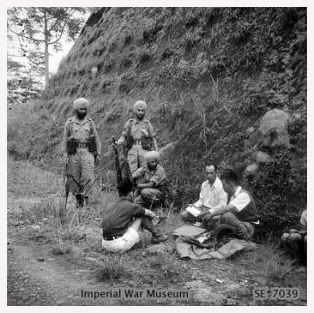
Army Film & Photographic Unit-Heren (Captain)
14th March 1946
Three Indonesian nationalists captured by the 36th Indian Brigade during the fighting in the Poentjak Pass, in which two Indian sepoys were killed. The 36th Brigade was tasked with clearing the northern road between Batavia and Bandoeng.
____________________________________
THE GRAVESTONE
BRIGADIER A.W.S. MALLABY
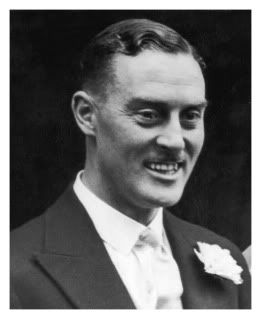
Brigadier Aubertin Walter Sothern Mallaby (1899 - 30th October 1945) was a British Indian Army officer who most notably was killed in a shootout during the Battle of Surabaya in what was then the Netherlands East Indies during the Indonesian National Revolution. At the time of his death, Mallaby was the Commanding Officer of 49th Indian Brigade which was part of the Allied Forces Netherlands East Indies (AFNEI).
Mallaby held the following posts during the later part of his Army career: Deputy Director of Military Operations in India (1941-1942), Director of Military Operations in India (1943-1944), Commanding Officer, 49th Indian Infantry Brigade in Netherlands East Indies (1944-1945).
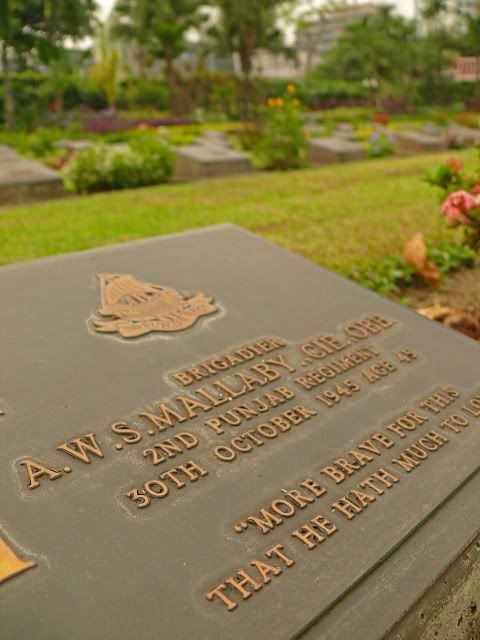
The Gravestone of A.W.S Mallaby on Djakarta War Cemetery

Anonymous Airman of Royal Navy
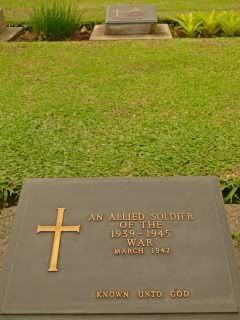
Anonymous Allied Soldier
The war end. But, the new mission just began.
Remembrance as we know them.